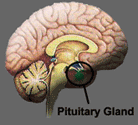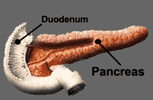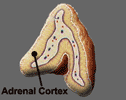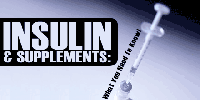Plowing over stacks of research, rummaging through my muscle building memory and compiling engaging information to help you (and me) respect and understand the intricate world of hormones is no day at Pleasure Point.
The facts, biochemistry, sequences of hormonal and enzyme activity and their interplay with nutrients in the bodies of healthy and unhealthy men and women, though pertinent and logical, is confusing when presented in an article intending to be bright and inspirational. Difficulty also arises when the reader is not a pre-med student but simply a guy or gal interested in getting in shape.
Hormones, vast in number and comprising an intricately interconnected system, are considered by scientists to be the body's most powerful biological agents, regulating almost entirely the chemical activities of the body. Their handiwork is reflected in the storage and distribution of excess bodyfat, the density and strength of muscle, levels of energy and sex drive and the symptoms of aging.
The foods we ingest are immediately attended by these amazing workers and they can serve us both positively and negatively. We can at some point and to a considerable degree control the activity of the hormones to optimize their effects on our health and longevity.

Five Hormones
The five hormones I have selected to sketch a rough profile are growth hormone, testosterone, insulin, glucagon and cortisol.
 Growth Hormone
Growth Hormone
-
Growth hormone, produced in the pituitary gland, is particularly involved in building muscle and directing the body to burn fat. Keep in mind that any efficiency we have in building, repairing and replacing muscle is also efficiency in retarding the aging process. Growth hormone cooperates well with insulin and testosterone in the muscle-building process.
 |
What Is The Pituitary Gland? A small oval endocrine gland attached to the base of the vertebrate brain and consisting of an anterior and a posterior lobe. A small oval endocrine gland attached to the base of the vertebrate brain and consisting of an anterior and a posterior lobe.The secretions of which control the other endocrine glands and influence growth, metabolism, and maturation. Also called hypophysis, pituitary body. |
 |
 |
||
This life-giving ingredient enhances immune function, inhibits early stages of arteriosclerosis and numerous symptoms of aging. It unfortunately declines in production as one gets older. Growth hormone is secreted in the early hours of deep sleep and it is positively affected by exercise.
 View Top Selling Growth Hormone Products Here.
View Top Selling Growth Hormone Products Here.
 Testosterone
Testosterone
-
Testosterone is the super hormone in men responsible, to a large degree, for his sexuality and male characteristics. It is to a much lesser degree present in women. It plays a powerful role in muscle building and fat burning and, like growth hormone, declines in production with age.
- Fitness
- Nutrition & eating patterns
- Rest
- Sleep
- Emotional stress
Testosterone levels fluctuate and can be increased by exercise, provided that over-training is not initiated and environmental variables are favorably controlled:
 View Top Selling Natural Testosterone Boosters Here.
View Top Selling Natural Testosterone Boosters Here.
 Insulin
Insulin
-
Insulin is the hormone secreted by the pancreas that's primary purpose is to transport blood sugar or glucose (derived primarily from carbohydrates) into the cells for energy. It also moves
amino acids into the tissues for their anabolic action. Not incidentally, insulin in excess is a very potent fat storage agent, a fat builder.
- Obesity
- Lack of exercise
- Excessive sugar intake
- Insufficient dietary fat
- Emotional stress
- Genetic predisposition.
 |
Pancreas The pancreas is a glandular organ that secretes digestive enzymes and hormones. In humans, the pancreas is a yellowish organ about 7 in. (17.8 cm) long and 1.5 in. (3.8 cm) wide. The pancreas is a glandular organ that secretes digestive enzymes and hormones. In humans, the pancreas is a yellowish organ about 7 in. (17.8 cm) long and 1.5 in. (3.8 cm) wide. It lies beneath the stomach and is connected to the small intestine at the duodenum. Most of the pancreatic tissue consists of grapelike clusters of cells that produce a clear fluid (pancreatic juice) that flows into the duodenum through a common duct along with bile from the liver. |
 |
 |
||
Any given person is more or less insulin resistant or insulin sensitive, depending on a wide variety of conditions including:
Insulin resistance is fast becoming the medical problem of this day and age.
When carbohydrates are eaten excessively, insulin remains chronically high and the cells over time adapt to its presence and become resistant to its function; additional insulin is demanded to carry on its job of transporting sugar into cells for energy, thereby lowering blood sugar.
The persistent and long-term elevation of insulin and glucose in the blood stream cause havoc on the system. Impaired insulin activity inhibits sugar burning and initiates its storage as fat (adipose tissue).
Damage to arterial walls result in cardiovascular disease and insulin-resistance might very well lead to adult-onset diabetes. It is noted that insulin and growth hormone are mutually antagonistic.
 |
||||
 |
|
 |
||
 |
||||
 Glucagon
Glucagon
-
Glucagon is also a product and secretion of the pancreas yet is exactly opposite of insulin in its action. Glucagon converts glycogen to blood sugar and insulin converts blood sugar to glycogen. Glycogen is unused glucose stored in muscle tissue or the liver to serve as energy when necessary.
- Chaotic blood sugar levels
- Appetite cravings
- Adipose development
- Loss of muscle
 |
Glucagon History In the 1920s, Kimball and Murlin studied pancreatic extracts and found an additional substance with hyperglycemic properties. Glucagon was sequenced in the late 1950s, but a more complete understanding of its role in physiology and disease was not established until the 1970s when a specific radioimmunoassay (a scientific method used to test hormone levels in the blood without the need to use a bioassay) was developed. |
 |
 |
||
To simplify, if you followed the order of events of macronutrient ingestion to their active place in the blood stream you would find that, eventually, insulin stores fat and glucagon mobilizes or burns fat. This can be a positive and healthy process if care in the initial manner, quality and quantity of ingestion is observed.
Careless administrators of eating habits risk:
Mood swings and energy dips often accompany over-consumption and misguided blood sugar reservoirs.
 Cortisol
Cortisol
-
Where growth hormone and testosterone are hormones that promote muscle building (anabolic), life extension, well-being, immunity, resistance, energy and fat burning, cortisol is the catabolic hormone.
It destroys muscle and contributes to undesirable fat storage. It is primarily a product of stress, real and imaginary. Stress prompts its release from the adrenal cortex and floods our system 24/7.
 |
The Adrenal Cortex The outer part of the adrenal gland, consisting of the zona glomerulosa, the zona fasciculata, and the zona reticularis and yielding various steroid hormones. The outer part of the adrenal gland, consisting of the zona glomerulosa, the zona fasciculata, and the zona reticularis and yielding various steroid hormones. The Adrenal Gland is either one of two small, dissimilarly shaped endocrine glands, one located above each kidney, consisting of the cortex, which secretes several steroid hormones, and the medulla, |
 |
 |
||
Over-training elevates cortisol levels, lack of sound sleep facilitates its destructive action and we find it everywhere at once competing with and compromising testosterone and growth hormones' anabolic action. Nutrition, sleep, stress-buffering attitude and exercise counter the enemy.
Behold the battle.
 View Top Selling Cortisol Blockers Here.
View Top Selling Cortisol Blockers Here.

Conclusion
You have just read my distillation of the raw material available to us in volumes of medical research dedicated to the metamorphosis of man and to his diseased or healthy condition.
Those hormones are a busy bunch. I offer the last dozen painful paragraphs for you to ponder, hold in your mental shirt pockets and reference from time to time as telltale words pop-up in muscle-talk and beg explanation.
My synopsis of the underlying activities of fat storage, muscle growth and hormones might shed some light in the dark corners where secrets are hidden. Or not. I slept at a Holiday Inn Express last night.

